 |
||
|
||
| ||
TYAN Debuts Dual Xeon DDR2 Server Board, New Transport Servers Toshiba Releases MDDI-Based VGA LCD Controller For 3G Handsets Microsoft Windows Smartphones To Run On TI's Platform Sony Ericsson Announces K610, J100 Mobile Phones Portwell Presents High-Performance Rack-Mount Internet Platform NVIDIA Introduces GoForce 5500 GPU For Mobile Phones Fujitsu Siemens To Unveil Pocket LOOX T Series TYAN Debuts Dual Xeon DDR2 Server Board, New Transport Servers Tyan introduced a highly-compact and versatile dual Intel Xeon server board: the Tiger i7322DP (S5353), a densely-packed server board with all of the features of full-size server boards, in a smaller package.  The Tiger i7322DP (S5353) uses the Intel E7320 chipset with an optimized 1U layout design on all components to allow for improved airflow over all parts of the motherboard. Features of the Tiger i7322DP include:
The Tiger i7322DP (S5353) is currently sampling, and will reach mass production levels shortly through mid-Q1'06. Other two novelties are two new Transport servers: GT20 (B3870) and GT20 (B5161), instant barebones server solutions which can enable customers to quickly build up their IT infrastructures in a short amount of time.  Both the Transport GT20 (B3870) and (B5161) provide a sleek, tool-less 1U Rackmount design and have a number of components which are included as standard with every Tyan Transport package, such as rails, heatsinks, extensive documentation, driver CD, front mount handles, and much more. Features of the Transport GT20 (B3870) include:
Features of the Transport GT20 (B5161) include:
The Transport GT20 (B3870 and B5161) are both currently sampling, and will reach mass production levels by the end of Q1'06. Source: Tyan
Toshiba Releases MDDI-Based VGA LCD Controller For 3G Handsets Toshiba today announced the introduction of the first MDDI-compliant LCD controller optimized for cell phones equipped with high-resolution VGA LCD displays. Dubbed the MDDI LCD Bridge and designated TC358720XBG, the highly integrated, single-chip device is suited for the new generation of advanced multimedia cell phones with MDDI interfaces, including 3G cellular handsets. It has a high-speed serial digital packet host interface that supports throughputs of up to 400Mbps by using two low-voltage differential signal pairs. Toshiba will start sample shipments in April 2006.
The MDDI LCD Bridge takes cell phone display resolution to the level of high-definition with support for VGA and W-QVGA LCDs. It optimizes low-power data transfers within cell phones, including video data transfers, through direct connection to the MDDI interface of QUALCOMM's Mobile Station Modem baseband LSI. Its design also integrates 8-megabits of embedded DRAM to improve color image quality. Equipped with an RGB interface plus an MPU interface, the device can control both a primary panel and a secondary panel. The image data needed to display images on two panels is stored in the embedded DRAM and only the updated parts of the display data need to be transferred from the baseband. When displaying still images, data need not be transferred from the baseband and this advance reduces the power consumption of the entire cell phone. The moving-image display function is supported on both the primary and secondary panels, and provides a mechanism for transferring image data to match the LCD display refresh timing. With the primary panel, it is possible to display VGA-size moving images and update only the locations displaying QVGA-size moving images, such as terrestrial digital broadcasts. This simplifies and reduces power consumption from baseband processing. 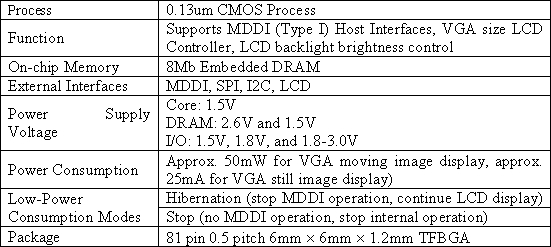 With the Toshiba "magic square algorithm", an RGB666 18-bit LCD panel can produce a display equivalent to that of an RGB888 24-bit LCD panel with up to 16-million colors. In addition, the algorithm enables display of 8-bit gray scale images even if the LCD panel only has a 6-bit gray scale capacity. The chip has independent 8-bit lookup table format gamma correction circuits for each color. The lookup table format converts 8-bit input into 8-bit output. This function permits fine adjustments to the brightness, even in LCD panels with a limited range of tones. The Mobile Display Digital Interface (MDDI) itself is a serial interface standard approved by the Video Electronics Standards Association (VESA). It provides an interconnect solution between the upper and lower clamshell in a flip phone, decreasing the number of signals that connect the digital base band controller with the LCD display and camera. MDDI is a high-speed solution that supports variable data rates and low-power consumption. Samples shipments are scheduled to begin in April 2006 with volume production planned to start in June 2006. Pricing is ¥900 each in 10,000-piece quantities. Source: Toshiba
Microsoft Windows Smartphones To Run On TI's Platform Today Microsoft and Texas Instruments announced that Amoi Electronics, HTC and Sagem Communication are developing new Windows Mobile-based Smartphones leveraging TI's OMAPV1030 EDGE chipset. These phones will be based on a lower-cost, high-performance chipset architecture for Windows Mobile device-makers. Until now, many smartphones running on a high-level operating system such as Microsoft Windows Mobile necessitated a more expensive dual-core chipset to power the rich user interface, data networking and additional personal and business applications. According to the press release, compared to previous multi-core architectures, this single-core solution offers significant costs savings on the total bill of materials. This has been achieved through higher levels of integration, more aggressive process technology and better system partitioning. Microsoft leveraged TI's OMAPV1030 chipset with its own Windows Mobile software to enable smart device capabilities at feature phone costs, thereby spurring smartphone market growth. Availability of these handsets is expected within 12 months. Source: Texas Instruments
Sony Ericsson Announces K610, J100 Mobile Phones Sony Ericsson today announces the K610, a slim, lightweight UMTS imaging phone, and J100, an intuitive and affordable everyday handset. 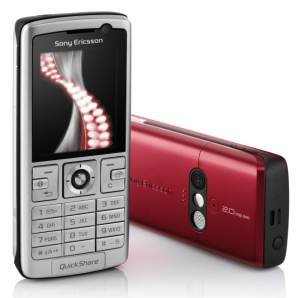 17mm thick and weighing 92 grams, the K610 is the size and weight of a typical 2G stick phone and is claimed to be one of the smallest and lightest 3G phones to come on the market. It packs a suite of advanced communications, business and entertainment applications plus a 2 Megapixel camera, Memory Stick removable storage and Bluetooth connectivity. As well as bright illumination plus large keypad and 262K colour display. The K610 has an integrated music player and supports Memory Stick Micro (M2) cards, which can be expanded to 1GB. The phone also has high-quality stereo headphones and built-in equaliser. The Sony Ericsson K610 is a Dual Mode UMTS handset commercially available in Evening Red and Urban Silver colours and starts shipping during Q2 2006. K610i - Dual mode UMTS (2100MHz) - GPRS 900/1800/1900 for Europe, Asia Pacific, Middle East, Africa. K610c - Dual mode UMTS (2100MHz) - GPRS 900/1800/1900 for Mainland China. The second novelty, J100, is a simple everyday device that is claimed to be the smallest phone in the whole Sony Ericsson range. It has 65K colour display and all key functions can be reached with one click and the navigation key with its icon markings makes for instant recognition of the various functions. The core voice calls and text functions are supplemented by alarm clock, calculator. Available accessories are the Car Holder HCH-60 and Portable Handsfree HPB-60. 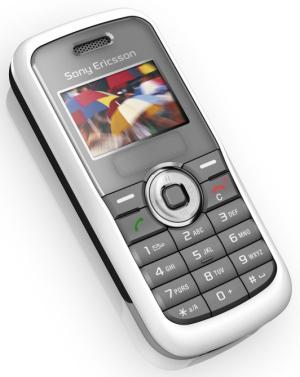 The Sony Ericsson J100 is a Dual Band GSM phone available in Polar White and Twilight Blue and will be commercially available during Q2 2006. The J100 will be available in the following variants: J100i - Dual Band GSM 900/1800 MHz for Europe, Middle East, Africa, Asia Pacific; J100c - Dual Band GSM 900/1800 MHz for Mainland China; J100a - Dual Band GSM 850/1900 MHz for Americas. Source: Sony Ericsson
NTT DoCoMo, Renesas Technology, Fujitsu Limited, Mitsubishi Electric and Sharp today announced that they will jointly develop a comprehensive mobile phone platform combining a single-chip LSI for dual mode handsets supporting HSDPA/W-CDMA and GSM/GPRS/EDGE, and core software such as operating systems. The new mobile phone platform will help accelerate the global adoption of W-CDMA services including FOMA, and lower the costs of these handsets. The companies expect to have the platform developed around Q2/FY2007 (July-September). The next-generation mobile phone platform is built on the previously developed single-chip LSI technology of NTT DoCoMo and Renesas since July 2004, which combines a baseband processor and the SH-Mobile application processor for dual-mode W-CDMA and GSM/GPRS phones. The jointly developed platform adds new functionality, such as support for HSPDA and EDGE technologies and full development support including OS, middleware and drivers. The platform can be implemented directly as a base system for W-CDMA handsets and eliminates the need for mobile phone manufacturers such as Fujitsu, Mitsubishi Electric and Sharp to develop a separate system for the common handset functions, significantly reducing the time and cost of development. At the same time, it allows them to invest more time and resources into developing handsets that are distinctive to them. The platform will be initially available for FOMA, and later for UMTS*5offered by Renesas. When the platform is widely spread and adopted, a further cost reduction of the handsets will be expected. Source: Renesas Technology
Portwell Presents High-Performance Rack-Mount Internet Platform NAR-2140 provides four Fast Ethernet ports for networking connection and one MiniPCI slot for the networking Encryption/Decryption & wireless LAN applications. NAR-2140 is equipped with 128MB memory for basic operation and offers one more memory slot for higher memory capacity. On the storage side, besides Flash-based storage media such as Compact Flash and DOM, customers can choose 3.5" IDE HDD as high capacity storage implementation. 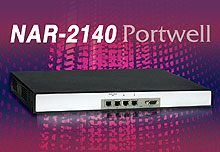 Feature List:
Source: Portwell
NVIDIA Introduces GoForce 5500 GPU For Mobile Phones
The newest member of the NVIDIA GoForce family of handheld GPUs, the NVIDIA GoForce 5500 delivers a host of multimedia features, including:
Phones based on the NVIDIA GoForce 5500 handheld GPU are expected to be available from key handset manufacturers before the 2006 holiday season. Source: NVIDIA
Fujitsu Siemens To Unveil Pocket LOOX T Series Fujitsu Siemens Computers will unveil its Pocket LOOX T Series to the public at the 3GSM World Congress, which started today in Barcelona. Featuring Windows Mobile Direct Push e-mail and UMTS mobile phone, this all-integrated handheld is a pocket-sized office that eliminates the need for multiple devices, the press release says. With Microsoft Windows Mobile 5.0 software and UMTS functionality, Pocket LOOX T series users have access to their e-mails, appointment calendar and other familiar Microsoft Office applications. And it has a standard QWERTY keyboard and bright TFT display (240x240) as well as an integrated GPS. The new high-end handhelds will arrive at shops in July for prices of approximately ˆ700. 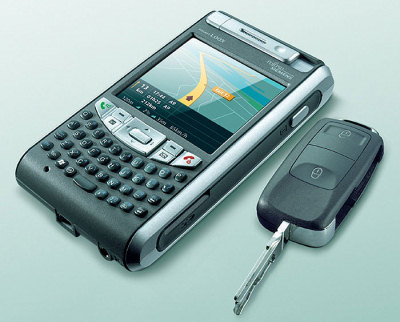 Highlights:
Source: Fujitsu Siemens Computers
Write a comment below. No registration needed!
|
Platform · Video · Multimedia · Mobile · Other || About us & Privacy policy · Twitter · Facebook Copyright © Byrds Research & Publishing, Ltd., 1997–2011. All rights reserved. |